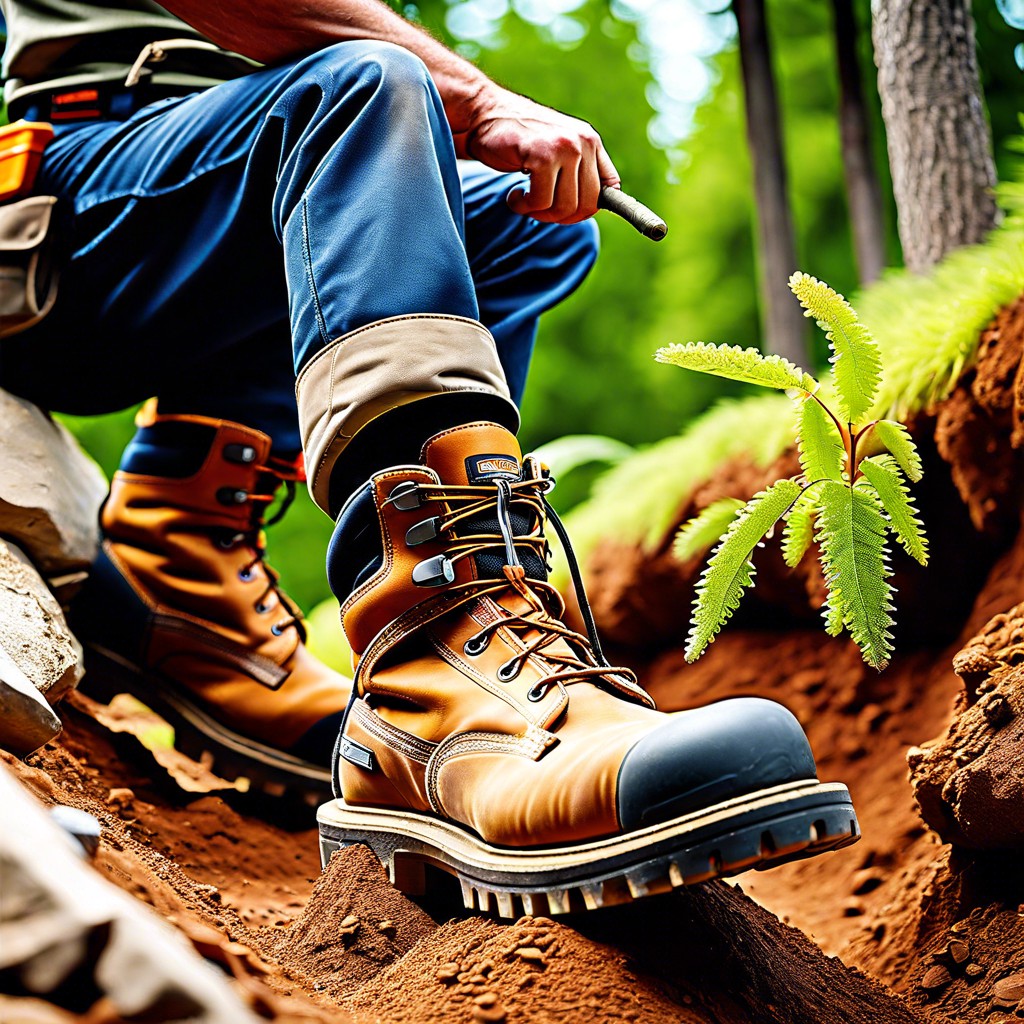Discover the top boots for landscaping that combine durability, comfort, and safety, ensuring you’re well-equipped for any outdoor task.
Key takeaways:
- Durable boots are essential for landscaping to withstand wear and tear.
- Look for waterproof boots to keep your feet dry in wet conditions.
- Choose between steel toe and composite toe boots for different levels of protection and weight.
- Slip-resistant boots are crucial for safety on uneven and slippery surfaces.
- Material and tread pattern impact slip resistance, so choose wisely.
Look Inside:
Importance of Durable Boots in Landscaping

Landscaping is tough on footwear. You’re constantly walking on uneven terrain and stepping on everything from wet grass to rocky paths, so durability is key. High-quality boots can withstand the daily wear and tear of landscaping work, preventing the quick breakdown that cheaper alternatives might face. This not only saves money in the long run but also ensures continuous protection and comfort.
Additionally, durable boots provide essential support for your ankles and cushioning for your soles, helping to minimize fatigue and avoid injuries on those long, tough days outdoors. Investing in a pair means peace of mind and more focus on creating beautiful outdoor spaces, rather than worrying about wet socks or sore feet at the end of the day.
Features to Look For in Landscaping Boots
When selecting boots for landscaping, a few key features can make all the difference in comfort and safety. First off, consider waterproof models to keep those toes dry in soggy conditions. Nobody likes squelchy toes while mulching, right?
Also, the choice between steel toe and composite toe boots can be crucial. Steel toe boots offer superior protection against heavy falling objects—a real foot-saver when dealing with large rocks or logs. On the lighter side, composite toes provide good protection but without the extra weight, making them comfortable for long wear.
Another significant feature is slip resistance. With landscaping, you’re often working on uneven and slippery surfaces. Boots with good grip can prevent those embarrassing slips and slides, ensuring you stay upright more often than not. Remember, landscaping isn’t ice skating; let’s keep it that way.
Waterproofing
Waterproof boots are essential for landscaping, given that you’re often exposed to morning dew, puddles, or unexpected rain showers. A wet environment not only makes your feet uncomfortable but can lead to blisters and other foot problems. Hence, seeking out boots designed with a reliable waterproof barrier will keep your feet dry and allow you to focus on the task at hand without distractions.
Materials such as leather treated with a water-repellent sealant or boots constructed with a waterproof membrane like Gore-Tex are top choices. These materials effectively block moisture from entering while still allowing your feet to breathe, preventing sweat buildup.
A quick tip: Always check if the stitching and soles are well-sealed to ensure complete water protection, as even the smallest gaps can let water seep through.
Steel Toe Vs. Composite Toe
When it comes to protecting your toes while landscaping, you’ve got two solid options: steel toe and composite toe boots. Steel toe boots are the traditional choice; they offer robust protection and can endure significant impacts. Think of them as the trusty tank of toe protection. However, they can be quite heavy, and during a long day of shifting soil and planting, that extra weight might make your feet feel like lead balloons by sunset.
On the flip side, composite toe boots offer a lighter alternative. They’re made from materials like Kevlar, carbon fiber, or plastic. While they don’t conduct heat or cold—which is a bonus for extreme weather conditions—they generally provide slightly less protection than steel toe boots. Yet, they’re perfect for those who prefer a quicker step without sacrificing safety standards.
Both types meet safety regulations, so your choice largely depends on your comfort preferences and specific job hazards.
Slip Resistance
Ever tried to navigate a slick, muddy slope while working in your garden? If yes, you surely appreciate the value of shoes that don’t let you down—literally. For landscaping, boots with excellent slip resistance are crucial to prevent the comedy of tumbles.
Here’s why slip-resistant boots are essential:
- Safety First: Landscapers encounter wet grass, slippery mud, and uneven terrain. Slip-resistant soles are designed with specific patterns and materials that grip the ground better than standard soles, reducing the risk of falls and injuries.
- Material Matters: Typically, these soles are made from rubber compounds with added traction; some even incorporate advanced technologies like Vibram, which offers extra grip even on slick surfaces.
- Design Details: It’s not just the material but also the tread pattern that counts. Deeper grooves and specific designs in the tread help channel water away from the sole, increasing contact with the ground.
Keep these points in mind next time you’re shoe shopping for your landscaping needs. Staying upright in muddy conditions could be just a boot away!